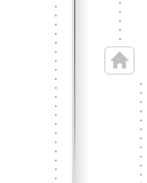Selection Tips for Choosing the Right LB
System for You
Design Concepts, Features and Performance
Contents
- Abstract.
- Design Concept and Features.
- Design of the different modules of the system:
4. Conclusion.
1. Abstract
An analysis of the main design concepts used in the manufacture
of today Langmuir-Blodgett (LB) film deposition systems is presented . A critical
comparison is made between the 4th generation of LB systems (500
series) designed by Advanced Technologies Ltd. (AT) and the last modifications
from its major competitors: Nima Technologies Ltd. (U.K.), KSV Instruments Ltd.
(Finland), and Nippon Laser and Electronics (NLE) Lab. (Japan). Analysed are
all major components: trough and barrier, temperature control, surface pressure
meter, barrier moving mechanism, film deposition system. Our aim is to help
our customers with competent advice on choosing the correct instrument for their
needs. We wish to draw attention on specific equipment problems and trade-offs,
which are not usually discussed in equipment leaflets, and which contribute
to the precision of operation and ease of work.
500 series from ATL is the best specified LB film deposition
system currently on the market. It is designed as a top performing equipment
for advanced research needs. Several new trends are incorporated in the design:
modularity Ц one system can work with different troughs for the different experiments,
or can be upgraded; open and compact design for easy integration with other
research equipment like microscopes, spectrophotometers, etc.; built-in features
for complete control of experimental conditions and work with different type
of compounds in different experiments. This is the only commercially available
system with built-in temperature control (option). With lower cost and improved
precision compared to external thermostat with cooling features, the built-in
temperature control allows complex experiments like isobars and isochores or
thermal cycling at given position of the phase diagram for film quality improvement.
The temperature range in the 500 series is considerably improved, compared to
400 series and now it is from 5 to 40 OC, software limited; the accuracy
of control is ▒ 0.05 OC within 1 hour from experiment start; the
desired temperature is usually reached within 10 minutes. Most importantly this
is the true temperature in the water subphase measured in the dipping well and
not the temperature anywhere else where we have shown that the errors can be
as high as 10 OC.
We were able to produce these highest quality very reliable
systems and at the same time maintain competitive prices on the market. How
did we achieve this? For two reasons. First we have started the design of the
500 series in 1997 while the models of our competitors are from late 80s or
early 90s. So we were able to use new components and feel the new trends. Second,
because of the specific situation in this country (Bulgaria was called the Silicon
Valley of the late communist countries, but due to current transitions many
top trained engineers were left without properly paid and challenging work)
we were able to hire quality engineers none of our competitors can afford to
hire. For example the chief mechanical designer of the 500 series has several
instruments still flying on the space station Mir.
^^top^^
2. Design concepts and features of the 500
series from ATL
The main design concepts in the 500 series are:
- Top specified extremely versatile system for advanced research investigations;
- Compact and open design for easy system integration with other research
equipment;
- Product superiority as regard precision, built-in features, ease of operation;
- Modular design: different troughs can be used for the different experiments
and can be changed within seconds by a patented method; completely modular
electronic block; easy upgrade from Langmuir to LB system;
- Extremely high reliability through the use of last generation electronic
components, special protective components, highest grade motors and other
mechanical components;
- Ease of serviceability for low downtimes in the unlikely case of malfunctioning.
Features as regard precision:
- Precise surface pressure meter with long-term drift and noise of ▒ 0.03
mN/m (with additional filtering ▒ 0.01 mN/m). This is the only surface pressure
meter implemented in an LB system which can measure with a true accuracy of
0.01 mN/m. This is in part due to the unique 22 bit resolution (for 100 mN/m
range the internal resolution is 0.00005 mN/m) Analogue-to-Digital Converter
with 1000 measurements per second;
- Precision manually driven vertical positioning of the surface pressure head
for easy calibration against water or other compound with known surface tension;
- Constant temperature control to within ▒ 0.05 OC after one hour
of stabilisation with the optional built-in temperature controller with no
commercial analogue;
- Constant pressure maintained to within ▒ 0.02 mN/m through a special algorithm;
- Maximum 10 readings per second of the parameters (surface pressure internally
is read 20 times per second) for high time resolution measurements. Averaging
filter with variable length can be applied to data;
- A choice of 8200 velocities for the barrier and substrate lift in the range
0.004 Ц 8 (options possible) mm/sec precisely maintained without generating
vibrations by a patented solution;
- Three compression methods: with constant velocity; equilibrium compression
with pressure steps and waiting for pressure to stabilise with time; constant
strain compression with linearly decreasing velocity;
- Position of the barrier and substrate lift measured with absolute accuracy
of 0.005 mm which is equal to 0.002 % of trough length;
- Temperature measured with a resolution of 0.01 OC and absolute
accuracy of 0.5OC;
- Built-in temperature compensation of surface pressure due to the change
of water surface tension with temperature.
Features as regard integration with other equipment:
- Even for a system with built-in temperature control the height from system
bottom to trough top between the barriers is 32 mm (for troughs with no borders).
This is less than the distance between the microscope objective and the microscope
table so the system can be placed directly on the microscope table. This is
the only full size commercially available system that can do that.
- Surface pressure module and LB film deposition module are only 35 mm in
thickness and smallest side dimension. Thus is minimised the disturbance of
laminar flown air;
- The system has the smallest footprint on the market with only 298 cm2
surrounding the trough (without the LB film lift). The standard trough itself
is with dimensions 30.4 x 20.4 cm and effective trough area of 600 cm2;
- The 500 series has a unique hand-held panel (option) with LC display on
which all important parameters during the experiment are displayed, large
LED display for over the room view of the most important parameter (can be
changed by a press of a button) and specially designed sealed keyboard for
manual control of the system. The standard cable is 2 m and the panel can
be placed on any convenient place. A longer cable can be ordered for work
from another room;
- For the different experimental setups different troughs can be used. The
exchange is within seconds without loosing the accuracy of measurements;
- We constantly manufacture equipment according to customer specifications
or needs. Sometimes this is free of charge.
Features as regard functionality and ease of work:
- Possibility to measure isobars and isochores with the optional built-in
temperature controller. No need to handle another instrument as the external
water bath controller. Multiple cycles of increase and decrease of temperature
at a given pressure or mean molecular area;
- 90 degree tiltable film lift (option) with readout for various modes of
deposition. Possibility to measure static or dynamic contact angles by the
method of Adams;
- Windows type GUI (graphics user interface) menu driven software. Easy to
learn and use but powerful;
- Online and context sensitive help;
- For ease of work the setup parameters are divided in 3: the parameters which
are specific for the experiment (typically only 6 or 8) are separated; setup
almost constant parameters (15) do not have to be filled every time; parameters
which are typical for the hardware or which optimise regulators (22) are protected
for accidental change by password. Default values with which any experiment
can be started are provided. Check for parameters to fall within sensible
limits is performed and if not warning appears. All setup parameters are stored
with the file of experimental data for subsequent view. On opening a data
file the experiment specific parameters are automatically loaded so an experiment
at same conditions can be started by only changing the file name. Two lines
for comments are provided;
- Three parameters for wait times before the experiment proceeds: for the
evaporation of solvent; for temperature stabilisation; for constant pressure
or area film stabilisation;
- Individual film lift velocities for the first layer and for movement up
or down;
- Real time full screen view of experiment progress. The screen view follows
the operation in progress, e.g. when LB film deposition is performed first
p - A isotherm is displayed and when the lift starts to move Transfer ratio
vs. lift coordinate is displayed. Autozoom of surface pressure axis for accurate
view. Experiment can be: a) halted for change of a few parameters like compression
velocity or targeted constant pressure and then the experiment continues;
b) stopped which stops all motions but data recording continues; c) quitted
which saves the data and exits the experiment.
- Powerful off line data analysis. Full screen graphics for maximum clarity.
White or black background for decrease of eye fatigue. Up to four Y-axes can
be selected as a function of the X-axis. Up to 4 files can be displayed simultaneously
in same coordinates. All possible combination of coordinates, including the
3 additional inputs, is possible. Calculation of compressibility modulus as
a function of mean molecular area. Multiple zooms. Precise readout of the
cursor pointer for identification of points on the graphics. Selection between
0 to 128 subsequent point averaging.
- The analysed data can be inserted directly into your document through the
Windows Clipboard and printed. Alternatively the binary files can be converted
to ASCII format with headers for point by point observation (included are
all experimental parameters) or without headers in columns for direct input
in graphical or analysis programs like Excel, Grapher, Mathlab, etc.
- Full range of lower cost (compared to the competitors) accessories so that
the system can be precisely tuned to the customer requirements.
- 3 free analogue inputs for high accuracy measurement of signals. Optional
one additional serial input.
- Possibility to emulate experiment with a pre-recorded data files for educational
or advertising needs.
Features as regard reliability and serviceability:
- The system is developed around latest generation highly integrated electronic
components. The decreased number of components leads to increase in reliability;
- Electronic hardware is developed around standard size modules which makes
easy to detect and repair the potential problem or upgrade the system;
- Highest quality DC servomotors from Maxon (Switzerland) are used and further
steps for increasing their life are taken;
- Highest quality stainless steel linear slide guides from Nippon Bearing
(Japan) are used;
- All other components used are from world leading companies like Bourns (USA),
Gates (England), etc.
- The estimated mean time between failures (MTBF) is 30000 hours. This means
that if the system is used 10 hours a day 300 days per year the first problem
may be expected after 10 years. We have heavily used equipment for 5 years
with no problems so far.
- The instrument has minimum electromagnetic emission. So no disturbance of
other sensitive laboratory equipment can occur. Highest quality linear power
supplies are used and linear motor and temperature control circuitry. So there
are no powerful sources of noise. Even the power transformer in the temperature
control unit is torroidal type for further decrease of emission.
^^top^^
3. Design of the different modules of the
system
3.1. Trough and barrier
Trough geometry
The wide variety of LB film applications requires flexibility
in the geometrical design of the trough. Sometimes special shapes and sizes
are needed. The use of original rectangular trough with moving barrier sliding
over the edge of the trough offers greatest flexibility in geometrical design
of the troughs. This is the design used by ATL, KSV, NIMA, and in some models
of NLE. In band and moving wall types of system, the band defines the trough
shape while acting as a barrier. In such a system the trough geometry is fixed
and cannot be changed to fit special applications. Further on the band and pulley
mechanisms are much more difficult to clean. The band is pushed outwards by
film pressure. Film collapses near corner post with condensed film. The mechanics
is complex and causing vibrations. In moving wall compression (used by NLE)
usable film area is determined by width of the substrate, moving wall scratches
sides of the substrate and there is no possibility for dipping of circular substrates.
In circular trough (earlier version and still offered by NIMA) the pressure
measurement is unstable due to uneven pressure distribution caused by the difference
of film speed at inner and outer trough perimeter.
In ATL we use almost square geometry (275 x 218 mm for the
standard trough, 600 cm2) to minimise film flow and the friction
with the side walls. NIMA has an aspect ratio of 3:2 and 600 cm2.
KSV has narrower design (510 x 150) which increases compression ratio. High
compression ratio, defined as the maximum to minimum usable area is important
when working with films in which surface pressures starts to rise at high mean
area per molecule. The ATL embeds the dipping well in the back wall (in some
models) to increase the compression ratio. In ATL the compression ratio is between
7 and 10 depending on the method of compression and model and is limited by
the space necessary for the Wilhelmy plate. To illustrate the importance of
compression ratio lets have the example of arachidic acid. With minimum mean
molecular area (mma) of 19 A 2 in a trough with ratio of 10 the compression
can start at 190 A 2 mma. High compression ratio is important in
surface potential measurement because changes in the potential are observed
at large areas earlier than changes in pressure.
ATL and NIMA systems have a uniform water depth of nominally
4mm over the whole trough area (the minimum stable depth for a water layer on
a hydrophobic surface). These are ideal for biological investigations of the
binding of proteins to model membranes, because the minimal subphase volume
economises on protein which is often precious. Smaller subphase volume also
improves the temperature control giving faster times for reaching the desired
temperature and more homogeneous temperature distribution. KSV have a trough
depth of 10 mm, NLE Ц 15 mm. Troughs for film deposition have a larger volume
of subphase, associated with a region in which the water is much deeper. This
dipping well allows deposition of the monolayer onto solid substrates by the
vertical LB dipping technique. In ATL we offer a shallow well of 14 mm depth
(35 x 35) which in most cases is sufficient for todayТs experimental techniques
(all kinds of microscopy and spectroscopy, X-ray diffraction, elipsometry, etc.).
The larger dipping well is 42 mm in diameter and 45 mm in depth and is ideal
for deposition on microscope slides (26 x 76 mm). Larger wells can be manufactured
on request but with the trade off of temperature accuracy and larger subphase
volume. Competitors usually offer larger dipping wells because they have never
fought the problem of even temperature control. It takes 1 hour for the water
to stabilise in the 42 x 45 mm well and it is exactly where the temperature
accuracy is important. Because on top of the well the deposition takes place
and nearby is measured the surface pressure. The longer the time for experiment
the more contamination falls from air. The subphase volume in ATL even for the
system with large dipping well is only 0.4 l. This is among the smallest on
the market.
Trough and barrier material
PTFE (polytetrafluoroethylene), known with its commercial name
Teflon, is generally accepted as the best material for LB systems because it
is inert, highly hydrophobic, and easy to clean with organic solvents, acids
and bases. However there are differences on how it is used. KSV uses form-sintered
PTFE with integrated dipping well. Thus no glue is used for the sealing of the
dipping and trough and there is no risk of contamination. But glue has to be
used when optical window is inserted in trough bottom. Further on we believe
that the small companies that perform this form-sintering do not have highest
level of technology, necessary for obtaining pure and porous free PTFE. That
is why we at ATL prefer the use of highest quality commercial PTFE solid blocks
from Norton Performance Plastics (USA) which is among the largest manufacturers
of PTFE products. Careful selection of glue ensures no contamination and high
quality seals. NIMA also uses this approach. NLE and other Japanese manufacturers
use PTFE coating on Aluminium. This is less expensive and ensures lower thermal
losses during thermal control. But it is known (also from LB literature) that
there is porosity and impurities caused by the spraying process, and contamination
with metal ions are observed. They cannot be repaired in case of scratches.
Barriers are usually also manufactured from PTFE. This is the
case of ATL and NIMA. PTFE has the advantage that can be cleaned with everything,
including strong oxidising agents for removing contamination. Although hydrophobic
PTFE barrier also drags the water upwards though to a lesser degree than the
alternative hydrophilic barrier. However the leaks are associated with three
contact point of barrier, trough edge, and air-water interface. KSV offer barriers
from the hydrophilic material Delrin (Acetal Homopolymer). It decomposes in
short time by strong acids and alkalis but can withstand chlorinated hydrocarbons
for cleaning. ATL offers this as an option for its barriers. The use PTFE coated
belts by NLE is subject to problems associated with belts mentioned above.
3.2. Temperature control.
This is the only commercially available system with built-in
temperature control (option). With lower cost compared to an external thermostat
with cooling features the built-in temperature control allows complex experiments
like isobars and isochores or thermal cycling at given position of the phase
diagram for film quality improvement. The temperature range in the 500 series
is considerably improved, compared to 400 series and now it is from 5 to 40
OC, software limited; the accuracy of control is ▒ 0.05 OC
within 1 hour from experiment start; the desired temperature is usually reached
within 10 minutes. Most importantly this is the true temperature in the water
subphase measured in the dipping well and not the temperature on the metal plate
below the Teflon trough or in the remote thermostat. We have shown that in order
to maintain the temperature at 5 or 40 OC the metal plate below the
trough should be kept at about 8 OC lower or higher temperature.
So all published isotherms at extreme temperatures measured so far without in-trough
thermometer should be regarded with great care.
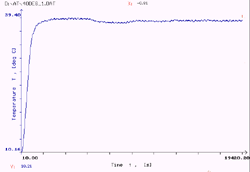
Constant temperature maintained at 38 OC.
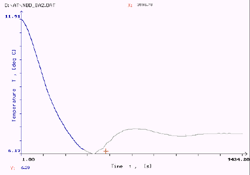
Constant temperature maintained at 7 OC.
After one hour from reaching the desired temperature the accuracy is ▒ 0.1OC
improving with time.
3.3. Surface pressure meter
Two basic designs exist of the Wilhelmy type surface pressure
meters. One of them uses linear position sensor (usually linear variable differential
transformer (LVDT)) for measuring the displacement of the Wilhelmy plate. The
measuring element (the anchor in the case of LVDT) is attached to a spring so
this becomes a force measuring unit. The advantages of this design are that
it is not breakable, linearity is higher, the noise is lower, and the unit is
more reliable. The drawbacks are the larger thermal drift if the environment
temperature changes, fatigue in the spring which may require recalibration,
and the change of the Wilhelmy plate position. The last drawback is solved with
today's high sensitivity designs so that total displacement at full range can
be made lower than 0.1 mm. The results presented below are with this type of
design.
The other design utilises an analogue microamperemeter on the
indicator arm of which is attached the Wilhelmy plate. The arm is illuminated
by a LED and throws shadow on a couple of photodiodes. The signal from the photodiodes
is used to maintain the arm in constant position and the surface pressure is
proportional to the current which flows in order to maintain that position.
The advantages and disadvantages are discussed above. The major disadvantage
is the fragility of the system. In fact the more accurate is the system the
more fragile it is. Some of our customers had problems with this. All our competitors
use this design. We also manufacture it and use it in our tensiometers.
The performance of our system is shown in the specifications
and is demonstrated below.
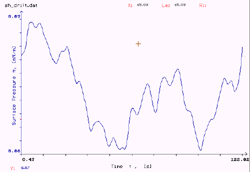
Noise in water ▒ 0.005 mN/m. 10 meas/sec. 2 minutes.
Averaging with K = 7.

Long term drift. 4 hour experiment. One measurement
every 5 seconds. No additional filtering. Drift is ▒ 0.04 mN/m. With additional
averaging the drift is ▒ 0.02 mN/m.
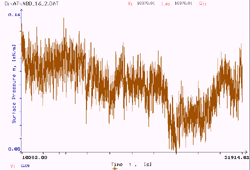
Drift in water for 6 hours. ▒ 0.05 mN/m. No filtering.
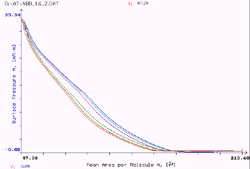
Reproducibility of surface pressure. 6 cycles of
compression and decompression. From upper curve to lower curve: 1st
compression, 2nd compression, 3rd compression, 1st
decompression, 2nd decompression, 3rd decompression.
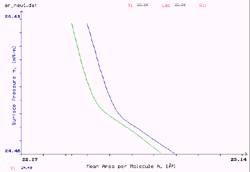
Reproducibility.
A difference of 0.125 mN/m of the inflex point of Arachidic
Acid
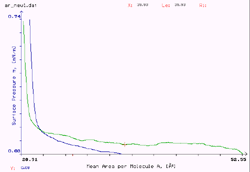
Reproducibility.
0.05 mN/m difference at low pressures. K = 5.
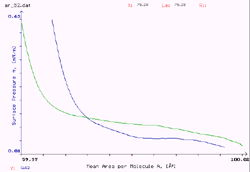
Reproducibility and noise in a real experiment.
Additional averaging on data points was applied K = 7.
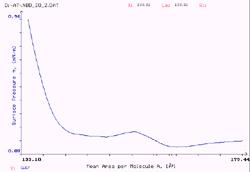
Liquid-gas coexistence region is clearly visible.
It is seen also that compression velocity was high (observed also at liquid
Ц solid coexistence).
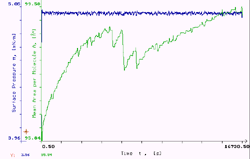
Constant surface pressure control at 5 mN/m. On
the inset is zoomed surface pressure. Accuracy is better than ▒ 0.03 mN/m.
Detailed comparison with other companies is not possible because
no one from our competitors gives detailed information on the performance of
their surface pressure meters. The parameters shown are the range Ц typically
0 Ц 100 mN/m, and a parameter, which they call accuracy Ц typically 0.004 mN/m.
But this is not accuracy. This is resolution and it is obtained by dividing
the range to the Analogue-to-Digital Converter resolution. NIMA and KSV use
16 bit resolution ADC. Compare this to ours 22 bit resolution ADC. Of this 16
bits, one is used for the sign, and remaining 15 bits give a resolution of approximately
1:32000. If you divide 100 / 32000 = 0.0031 you obtain the specified by them
accuracy. But this is far from being true. First from theory of measurement
it is known that you should have at least 4 times higher resolution to avoid
discretization noise. ThatТs why in all our internal calculations we use 18
bit resolution. More importantly, the actual accuracy is limited by noise, long
term drifts, repeatability, and nonlinearity. These parameters are specified
for every analytical balance and the surface pressure meter is largely an analytical
balance. But they are not specified by our competitors. It is true that in Langmuir
film experiments absolute accuracy is limited by external factors like wetting
angle, calibration accuracy, etc., to about 0.1 mN/m. But relative accuracy,
i.e. a step or transition in an isotherm, is much higher. With our system we
demonstrate measurement of liquid-gas coexistence region which is in our case
(NBD Ц DPPE molecule) only 0.1 mN/m above the gas phase. From what we know about
our competitors no one can measure this.
Demonstration of Isobars experiments.
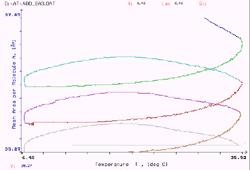
7 temperature cycles between 6.5 and 35.5 OC.
The pressure was kept constant at 30 mN/m. On the lower curve is shown the change
of area with temperature. This experiment would not be possible without the
built-in compensation of water surface tension change with temperature.
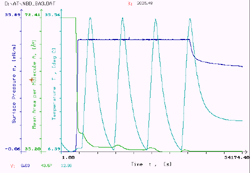
Change of Mean Area per Molecule with temperature.
Relaxation of monolayer with temperature cycling can be observed. Its thermal
expansion coefficient can be calculated. Excellent reproducibility can be noticed.
^^top^^
3.4. Mechanical modules
We use the best possible design for both the barrier module
and the lift module. This is the use of DC servomotors with analogue tachometer
feed back loop for maintaining constant velocities. NIMA uses DC motors but
the tachometer feed back is only an option, that is why their range is limited
to 1:200. KSV uses DC motor only in their lift but with digital feedback Ц hence
the dynamic range is limited to 1:100. For their barrier mechanism they use
stepper motor in microstep operation. But when you specify a range of 1:40000
this means that the motor makes a step and then waits for several seconds. This
inevitably generates surface waves and vibrations. NIMA and KSV use 12 bit Digital-to-Analogue
Converters for motor control. Compare this to ours 14 bit DACs. We have 4 times
better resolution which we can utilise by our mechanical design.
In our case we use linear tachometer feed back as opposed to
pulse-width modulation control. For small motors this is a far superior solution
which increases motor life and decreases unevenness of motion. This in combination
with the most precision slide rails and precision position sensors, attached
to the end stage for true position readout, produces the best mechanical design.
This is important not only for smooth, even, vibration free motion with large
velocity range. This is important also in the surface pressure control in which
the barrier acts as a feed back.
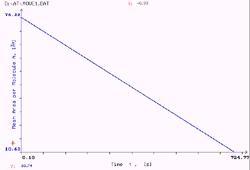
Accuracy of barrier motion. The area decrease versus
time is an absolute straight line with no deviations, indicating unevenness
or vibrations. The best way to test mechanics is to put your finger on a quickly
moving barrier or lift. You can feel the smooth motion and you can see the difference
with competitors.
^^top^^
4. Conclusion
Here we have presented proof that the 500 series of Langmuir-Blodgett
film deposition equipment from Advanced Technologies Ltd. is the most accurate
and versatile system on the market. What is more, our system is at least 10
times more precise in all important parameters than the comparable system of
our major competitor Ц NIMA Technology (U.K.). Compare:
- the surface pressure sensor nonlinearly: 1 % NIMA Ц 0.1 % ATL; look at our
noise of only 0.005 mN/m. The real values of our competitors is not known.
- accuracy of barrier position measurement: 1 % NIMA (multiturn potentiometer)
Ц 0,002 % ATL (encoder);
- accuracy of temperature control: 0.05 deg. C ATL Ц 7 deg errors at 5 or
40 deg C if no feedback thermometer is provided from the trough dipping well
to the thermostat, which is not usually done.
- velocity dynamic range: 1:200 NIMA Ц 1:10 000 ATL
- resolution of the used electronics: for the ADC: 16 bit NIMA Ц 18 bit ATL
out of 22 bit ADC; for the DACs: 12 bit NIMA Ц 14 bit ATL.
KSV (Finland) system is better compared to NIMA. Very little
official information is provided so what can be said at this moment is that
our system is at least as precise as KSV in points 1 and 2 above. The rest 3
points are absolutely true again. And even the low cost models of KSV are approximately
2 times more expensive than a 500 system.
Our software is more powerful and with more features. All possible
data analysis functions are built-in. Export of the data file and setup parameters
in ASCII format is available for data import in other software. The software
has self-test and self-calibration features to make the system easy for work.
Software protection of the system is combined with hardware protection in all
modules. This adds to system reliability and to fault tolerance.
We are currently establishing contacts with leading companies
to distribute our products in the corresponding countries. This will give our
products unparalleled support and our customers - piece of mind.
Last but not least, our prices are at least 10 % lower than
the lowest prices on the market Ц the NIMA prices. And NIMA in most countries
operate without local distributor so it can not provide the customersТ support
that our distributors can.
^^top^^
|













